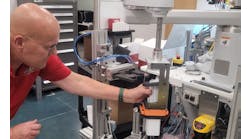Read the full Workforce Week series
Apart from learning the technical principles of monitoring and managing process applications, it's also increasingly crucial for engineers and technical professionals of all ages to learn the soft skills of interpersonal communications needed for collaboration inside and outside their organizations.
"Many manufacturing and advanced technical jobs are going unfilled because it's hard to find people with the right skills, but there's also a gap in academic and workplace competency because candidates also lack the soft skills such as oral and written communication they need to solve problems and participate on teams," says Chris Paynter, dean of science, technology, engineering and math (STEM) at Central Piedmont Community College in Charlotte, N.C. "The pace of technical change means everyone must be continually learning, but developed skilled personnel is easier for companies that sponsor students and apprentices. Germany and Europe in general have long traditions in this area, of course, but when representatives of their schools visit us, they report that community colleges in the U.S. are doing a good job of blending technological and academic education."
More recently, local employers and CPCC faculty have jointly developed a critical core for soft skills, critical thinking and others, which the college can use to self-assess its courses based on how well students are learning the competencies they and their eventual employers need. "Soft skills are valuable because they help students communicate, solve problems and conduct interviews with their teams, companies and customers," says Paynter. "It's also important to learn these skills soon because companies often bring students in early in their academic careers as part of on-campus programs, apprenticeships or onsite co-op programs."
Paynter adds that soft skills can also help users and their organizations manage data, dashboards and informational graphics from IIoT and other digitalized devices. "We're even developing a curriculum to help students quickly analyze and visualize information from next-generation equipment," adds Paynter. "We're finding most members of this digital generation bring a strong work ethic, creativity and analytical skills. Plus, they know how to keep up with change, realize they won't be done when they graduate, and understand they'll have to be lifelong learners. This is another reason why it helps for them to encounter perpetual workplace mentorships and coaching cultures during their internships and co-op programs. Senior staff members at many companies want to give back and help the next generation, but management has to put programs like this in place."
Apprentice lessons
Of course, some of the most instructive workforce development strategies are those carried out by employers, schools and governments in Europe and elsewhere, and they provide many examples that others can use if they're willing.
To move beyond the traditional come-to-us mindset of want ads, there are several primary steps that process industry firms and other organizations can follow to market, attract, hire and retain new personnel:
- Research and develop ties to local elementary and high schools, community colleges, colleges and universities, and related organizations that can help produce new operators, technicians and engineers. Attend and exhibit at their job fairs and other events.
- Evaluate if classes at nearby schools convey skills your staff will need, and if not, ask for necessary updates or additions; assisting in creating new courses; and maybe teach if possible. Most U.S. community colleges have long histories of developing curricula to help meet the needs requirements of businesses in their districts.
- Establish job-shadowing, internship, externship and apprenticeship programs that can expose young and old students to your firm's technical philosophy and methods strategies, and teach them to do essential tasks, and evaluate their suitability with more difficult jobs.
- Host open houses and facility tours for residents in wide geographical radius to make local community aware of your firm and what it does, so they'll start to think of it as a source of technical employment.
- Join, mentor and sponsor available technical enrichment efforts, such as science, technology, engineering and math (STEM) programs and FIRST Robotics or similar teams.
Request that regional technical conferences and exhibitions invite more students, schools, families and the general public, which can introduce new people to your industry's technologies; increase the chances for positive cross-pollination among individuals and organizations; and lead to more possible talent sources.
"Everyone's experiencing accelerating retirements with experienced individuals leaving and workload increases for those who remain. At the same time, customers are demanding more intelligent, faster and more powerful technologies, so it's more important than ever to have effective engineering and plant operations," says Joe Podolsky, director of business transformation and planning at Servomex Group Ltd., a global gas measurement and analysis supplier. "About 15 years ago, we crossed the chasm of using PCs and tablets. Now, users are pretty fluent with computers, but they're less savvy about using process data for better decisions, not to mention working with IT to maintain cybersecurity, especially at the device and instrument levels. The question is how to keep experienced people on staff and enrich their day-to-day interactions, and simultaneously attract new people with exciting, cutting-edge technologies that can make engineering sexy again."
Podolsky adds that traditional apprenticeship programs in the U.K. and Europe have long given students training, practical work experience and careers after identifying skills needed and the ingredients to develop them. "Government promotes and coordinates most apprenticeship programs in the U.K., grants incentives for companies to establish them, and grows them at regional technical colleges," says Podolsky. "They were already well-established in the 1970s, but waned in the 1980s-90s, which was recognized before they were reestablished about 10 years ago. Students typically spend three or four days per week at a company's work environment and the rest of the time in class getting the technical background they need."
Podolsky reports that Servomex participates in its local apprenticeship system, which identifies technically talented students at a young age, later matches them with potential industries and businesses, and usually provides two years of baseline technical education, so they can serve in entry-level technical positions. "There's always a portfolio of people to choose from, but as they get further into their careers, it can get more challenging to develop and find those with more specialized skills, such as IT or software/firmware," explains Podolsky. "The shift to software and other technical changes are happening fast, so the refresh cycle on our products is getting shorter and customers want enhancements immediately. This is why we need people with the latest, updated skills, and give them the software and IT training they require either with us or with partners. This has to happen during the next two to five years because whoever doesn't do it is going to fall behind."
Amanda Beaton, U.S. program manager for Siemens Cooperative Education, reports it brought the global program to the U.S. about seven years ago, and it connects hundreds of schools like Georgia Tech, University of Toledo and Kennesaw State University (formerly Southern Polytechnic State University) with relevant, industrial, factory automation technologies to give students real-world, hands-on experience. "We're seeing more emphasis on getting these technologies into classes and labs because if students can learn them hands-on, then it's easier to onboard them when they're hired," says Beaton. "More schools are investing in curricula and skills-based learning available through the SCE program, and several have progressed into topics like IIoT, virtual machines, and digital twins."
Beaton reports that potential users and companies can find SCE partner schools at its Partner School Finder web-tool. If there isn't a school nearby, then Siemens can invite instructors to attend a free training events, and take home hardware and software starter kits to introduce the technology into a program. "New technologies can be intimidating for anyone, so we offer free introductions and instruction whenever we can online and in person. SCE's curriculum isn't limited to colleges. High schools, research institutions, and even union training facilities use SCE," adds Beaton. "Of course, there are many downloadable courses and projects, and they're often matched with available, deeply discounted hardware. There are also certificates of completion, digital badges, and a new open-source software platform recently introduced with the Siemens IoT2040 gateway. Even elementary school students can benefit from this type of easy-to-adopt technology. We're showing digitalization and automation concepts to a local Girls Who Code chapter in Johns Creek, Ga, where my two daughters attend school."
On the leadership side, Podolsky adds that Servomex faced its own workforce-related crisis following challenges raised by the 2014-15 recession in the hydrocarbon industries. It changed its leadership to focus on new ideas, and further transformed the organization over the past two or three years. “The management team is compassionate, engages with more people, breaking down former hierarchies, and is interested in knowing what challenges employees are facing and how to resolve them,” says Podolsky. “This makes a big difference in whether people want to stay or go elsewhere. Everyone wants to feel like they're part of a family, that they have a common purpose, and they can all contribute. If managers and leaders respect their staff and invest in supporting them, then they can all be successful.”







